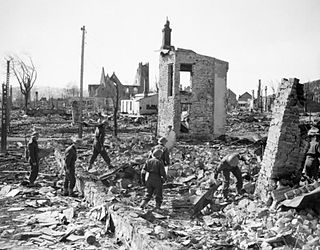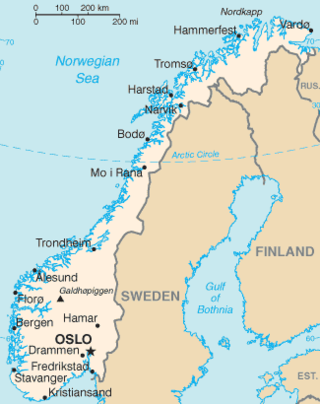
Narvik is the third-largest municipality in Nordland county, Norway, by population. The administrative centre of the municipality is the town of Narvik. Some of the notable villages in the municipality include Ankenesstranda, Ballangen, Beisfjord, Bjerkvik, Bjørnfjell, Elvegård, Kjøpsvik, Skjomen, Håkvik, Hergot, Straumsnes, and Vidrek. The Elvegårdsmoen army camp is located near Bjerkvik.
The Battles of Narvik were fought from 9 April to 8 June 1940, as a naval battle in Ofotfjord and as a land battle in the mountains surrounding the north Norwegian town of Narvik, as part of the Norwegian Campaign of the Second World War.

Sweden maintained its policy of neutrality during World War II. When the war began on 1 September 1939, the fate of Sweden was unclear. But by a combination of its geopolitical location in the Scandinavian Peninsula, realpolitik maneuvering during an unpredictable course of events, and a dedicated military build-up after 1942, Sweden kept its official neutrality status throughout the war. At the outbreak of hostilities, Sweden had held a neutral stance in international relations for more than a century, since the end of the Napoleonic Wars in 1814 and the invasion of Norway.
Swedish iron ore was an important economic and military factor in the European theatre of World War II, as Sweden was the main contributor of iron ore to Nazi Germany. The average percentages by source of Nazi Germany’s iron ore procurement through 1933–43 by source were: Sweden: 43.0 Domestic production (Germany): 28.2 France: 12.9. Within the German military the Navy was most dependent on Swedish steel as an absolute necessity to the German war effort, according to their grand admiral. It has also been argued that the Swedish export helped prolong the war.

The Norwegian campaign involved the attempt by Allied forces to defend northern Norway coupled with the resistance of the Norwegian military to the country's invasion by Nazi Germany in World War II.

The Namsos campaign, in Namsos, Norway, and vicinity took place between Anglo-French and Norwegian naval and military forces against German military, naval and air forces in April and early May 1940. It was one of the first occasions during the Second World War when British and French land forces fought the German Army.
The Norwegian Campaign, lasting from 9 April to 10 June 1940, led to the first direct land confrontation between the military forces of the Allies—the United Kingdom and France— against Nazi Germany in World War II.

Operation Wilfred was a British naval operation during the Second World War that involved the mining of the channels between Norway and its offshore islands to prevent the transport of Swedish iron ore through neutral Norwegian waters. The Allies assumed that Wilfred would provoke German retaliation in Norway and prepared Plan R4 to occupy Narvik, Stavanger, Bergen and Trondheim. On 8 April 1940, the operation was partly carried out but was overtaken by events, when the Germans began Operation Weserübung on 9 April, the invasion of Norway and Denmark, which began the Norwegian Campaign.

The occupation of Norway by Nazi Germany during the Second World War began on 9 April 1940 after Operation Weserübung. Conventional armed resistance to the German invasion ended on 10 June 1940, and Nazi Germany controlled Norway until the capitulation of German forces in Europe on 8 May 1945. Throughout this period, a pro-German government named Den nasjonale regjering ruled Norway, while the Norwegian king Haakon VII and the prewar government escaped to London, where they formed a government in exile. Civil rule was effectively assumed by the Reichskommissariat Norwegen, which acted in collaboration with the pro-German puppet government. This period of military occupation is, in Norway, referred to as the "war years", "occupation period" or simply "the war".
Operation Ikarus was a Second World War German plan to invade Iceland, which had been occupied by British forces during Operation Fork in 1940. The plan was never realized.

Convoy PQ 1 was the first of the Arctic Convoys of the Second World War to have the code prefix PQ, which was chosen from the initials of Commander Phillip Quellyn Roberts, an operations officer in the Admiralty. The Western Allies used the Arctic route to supply the Soviet Union after the beginning of Operation Barbarossa, the German invasion, which began on 22 June 1941.

Convoy PQ 2 was the third of the Arctic Convoys of the Second World War by which the Western Allies supplied the Soviet Union after Operation Barbarossa, the German invasion, which began on 22 June 1941. The convoy sailed from Scapa Flow and arrived safely at Archangelsk.

The Reichskommissariat Norwegen was the occupation regime set up by Nazi Germany in German-occupied Norway during World War II. Its full title in German was the Reichskommissariat für die besetzten norwegischen Gebiete. It was governed by Reichskommissar Josef Terboven until his deposition on 7 May 1945. The German military forces in Norway, then under the command of general Franz Böhme, surrendered to the Allies on 9 May and the legal government was restored.
This page is about the effects on Sweden, during and following Operation Weserübung.
For articles about the operation itself, see also Operation Weserübung and Norwegian Campaign.

During the early stages of World War II, the United Kingdom and France made a series of proposals to send troops to assist Finland against the Soviet Union during the Winter War, which started on 30 November 1939. The plans involved the transit of British and French troops and equipment through neutral Norway and Sweden. The initial plans were abandoned because Norway and Sweden declined transit through their land for fear that their countries would be drawn into the war. The Moscow Peace Treaty ended the Winter War in March 1940, which precluded the possibility of intervention.

Operation Weserübung was the invasion of Denmark and Norway by Nazi Germany during the Second World War and the opening operation of the Norwegian Campaign.

Narvik is a town and the administrative centre of Narvik Municipality in Nordland county, Norway. The town is located along the Ofotfjorden in the Ofoten region. The town lies on a peninsula located between the Rombaken fjord and the Beisfjorden. The European route E06 highway runs through the Beisfjord Bridge and Hålogaland Bridge crossing the two small fjords surrounding the town.

SS Nordnorge was a Norwegian steamship built in 1923–24 by Trondhjems mekaniske Værksted, for the Narvik-based Norwegian shipping company Ofotens Dampskibsselskap. First employed on the company's Narvik-Trondheim route, she was transferred to the longer Hurtigruten route in late 1936. Seized by the Germans following their April 1940 attack on Norway, she was used as covert troop ship and was sunk shortly after delivering her cargo of German troops behind Allied lines on 10 May 1940.
The Capture of Arendal occurred on 9 April 1940 and saw the German torpedo boat Greif land a force of bicycle troops and seize an invasion beachhead at the Norwegian port town of Arendal. The main aim of the landing, part of the German invasion of Norway, was to sever the undersea telegraph cable between Arendal and the United Kingdom.

Convoy QP 1 was the first of the Arctic Convoys of the Second World War by which the Allies brought back ships that begun carrying supplies to the Soviet Union after Operation Barbarossa, the German invasion of 22 June 1941. The convoy sailed from Murmansk and arrived safely at Scapa Flow in Orkney.













